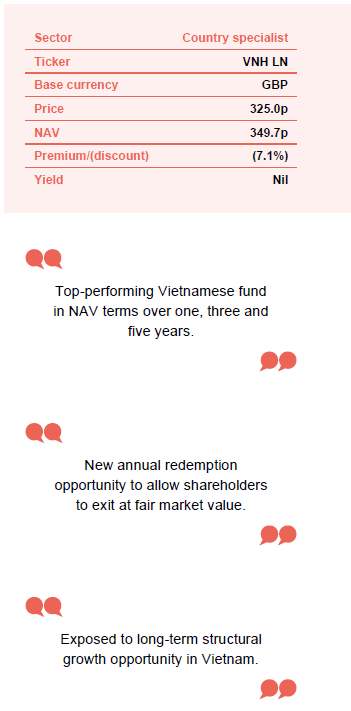Vietnam Holding Limited
Investment companies | Annual overview | 15 December 2023
Bringing you redemption
Vietnam Holding (VNH) continues to provide both a peer group and benchmark beating performance (it is the top-performing Vietnamese fund in NAV terms over one, three and five years – see pages 18 to 20) and, aided by Vietnam’s long-term structural growth drivers, its manager continues to see very strong growth runways for its stocks. Despite this, VNH has, until very recently, been hampered by a low double-digit discount to net asset value (NAV) that has been persistent and unjustified (see page 23).
VNH’s board is proposing to replace the company’s biannual tender offers with an annual redemption opportunity (see page 24). This would allow shareholders to exit at fair market value, could narrow the discount and maybe help VNH to re-expand.
Capital growth from a concentrated portfolio of high growth Vietnamese companies
VNH aims to provide investors with long-term capital appreciation by investing in a portfolio of high-growth companies in Vietnam. These should come at an attractive valuation and demonstrate strong environmental, social and corporate governance awareness. It achieves this by investing primarily in publicly-quoted Vietnamese equities, but it can also invest in unlisted companies and can hold the securities of foreign companies if a majority of their assets and/or operations are based in Vietnam.
At a glance

Fund profile – listed Vietnamese equities with strong ESG focus
Further information on VNH can be found at the company’s website: www.vietnamholding.com
VNH is a closed-end fund, legally-domiciled in Guernsey, that aims to provide investors with long-term capital appreciation by investing in a concentrated portfolio of high-growth companies in Vietnam that demonstrate strong environmental, social and corporate governance (ESG) awareness.
VNH invests predominantly in publicly-traded companies in Vietnam, but it may also – subject to certain restrictions – invest in foreign companies if a majority of their assets and/or operations are based in Vietnam (up to a maximum of 25% of its net assets). It can invest in equity-like securities, such as convertible bonds, and may also hold private companies (up to a maximum of 20% of its net assets). More information on Dynam Capital, VNH’s investment manager, is provided on pages 27, while further information on the manager’s ESG-orientated investment process, including investment restrictions, is provided on page 9.
VNH does not have a formal benchmark. However, for the purposes of performance evaluation, the manager has traditionally included comparisons against the VN All-Share, the VN 30 Index and the MSCI Emerging Markets Index in its literature. We have used these as well as the MSCI Vietnam Index in this report.
Market outlook and valuations update
Recent history and valuations
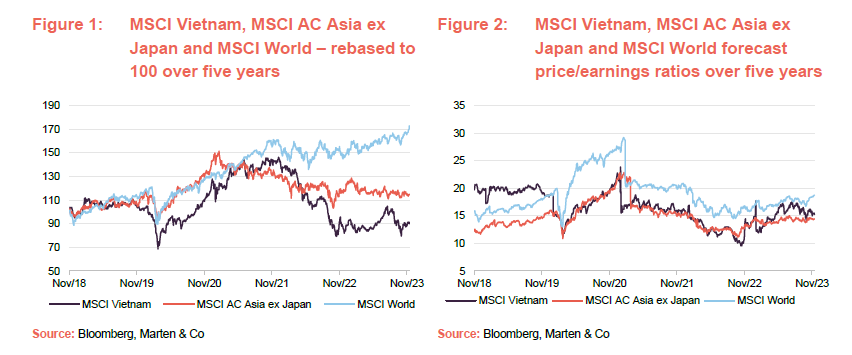
In our previous notes, we have discussed how from late 2021 through 2022, Vietnam and emerging Asia’s equity markets decoupled from global equity markets, giving back some of their previously strong performance during the post-pandemic period, as is illustrated in Figure 1. During this period, Vietnam and its emerging Asia peers suffered from general negative sentiment towards Asia, which was largely driven by problems within China, where a failure to get to grips with the coronavirus led to extensive lockdowns with associated social unrest. This in turn highlighted the over-reliance of many producers’ supply chains on China. Concurrently, a more challenging outlook developed for the region’s export markets, as central banks hiked interest rates to bring rapidly rising inflation back under control. This period weighed on growth equities in particular and so it is not surprising that fast-growing Vietnam, and emerging Asia more broadly, suffered.
As is also illustrated in Figure 1, both emerging Asia and Vietnam’s absolute performance have stabilised over the last 12-18 months. The Vietnamese stock market suffered a setback in response to a property debt and corporate bond market crisis towards the end of 2022 (see pages 4 to 6 of our June 2023 note). However, aided by interest rate cuts, increasing levels of foreign direct investment (FDI), and a record trade surplus (in this instance because imports fell faster than exports), the market settled during the first three months of 2023, with flows from both local and regional investors driving a marked recovery.
Vietnam has a very open economy, and weaker global demand for technology goods has hit its usually high export growth. This has impacted consumer confidence, pulling down imports too, which when combined with rising FDI have enabled Vietnam to keep a relatively stable foreign exchange balance over 2023, in contrast to Dong weakness in 2022. Domestic inflation has also stayed under control. The country has a relatively low energy exposure in its cost of goods basket versus say Europe and the US, as half of its energy is sourced domestically.
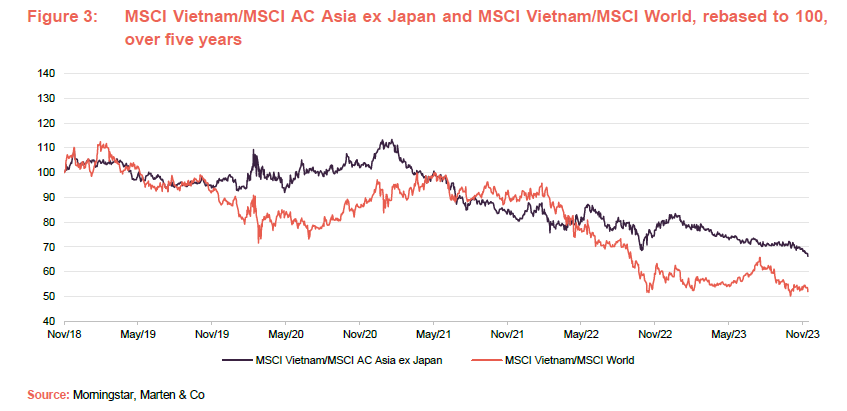
As discussed in the performance s`ection of this note (see page 18), the Vietnamese market suffered a correction during September and October. Weaker than expected third quarter earnings, particularly from the larger conglomerates; higher volatility in the foreign exchange market; and rising uncertainty as tensions have intensified in the Middle East have led to outflows, particularly from retail investors. The market settled again in November, but Vietnam continues to look cheap versus its longer-term history and global equities more generally, although more expensive than the broader emerging Asia region. This reflects its stronger growth prospects, which are explored further below.
Vietnam – strong GDP per capita catch-up potential
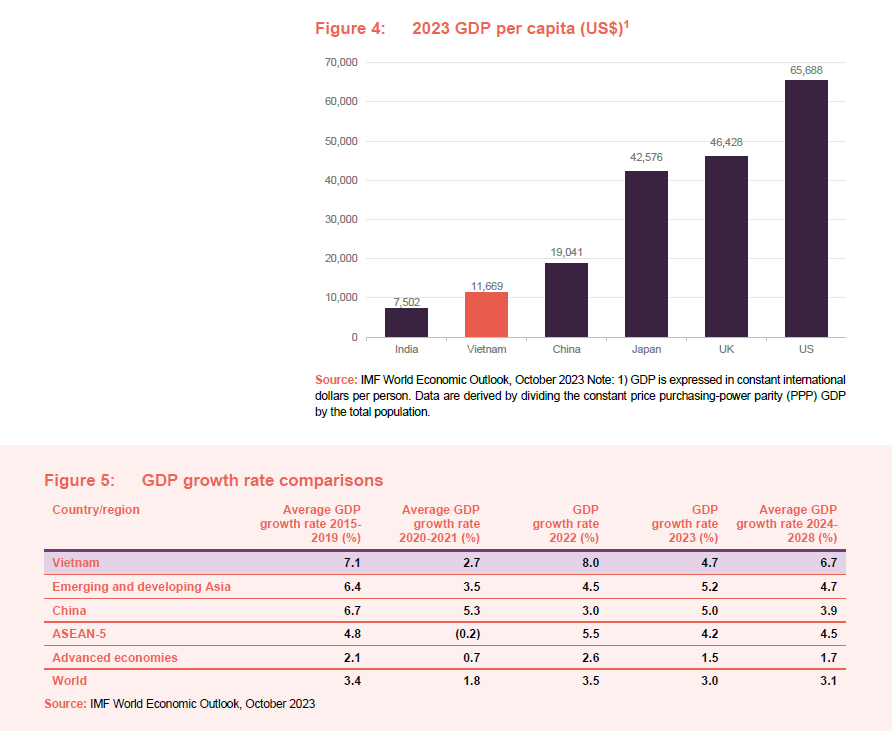
Despite its progress in recent years, Vietnam remains at a very early stage of its development and continues to offer a long-term structural growth opportunity. The Indian equity market has posted a particularly strong performance over the last couple of years, but Vietnam’s GDP per capita growth continues to outpace India’s and remains over half of China’s level. However, Vietnam’s GDP per capita remains significantly below those of more developed nations (see Figure 4). It is clear that Vietnam still continues to offer significant catch-up potential.
Vietnam is still at a very early stage of development, and therefore continues to offer significant catch-up potential.
The IMF’s World Economic Outlook for October 2023 forecasts average annual growth for Vietnam for the period 2024-2028 of 6.7%. This is in excess of China’s, above the average for the ASEAN peer group and significantly above world and developed market averages. It is also worth noting that IMF’s estimated growth rate for China is on a gradually decreasing trend for the next five years (from 5.0% in 2023 to 4.2% in 2024, to 4.1% in 2025, 4.0% in 2026, 3.6% in 2027 and 3.3% in 2028). In comparison, while Vietnam’s growth is expected to fall back to 4.7% from 2022’s particularly high level of 8.0%, it is expected to grow for the next three years and remain elevated (to 5.8% in 2024, 6.9% in 2025 and 6.8% for 2026 to 2028).
Manager’s view – 2023 brings growing sense of order in Vietnam
Vietnam’s long-term growth drivers are intact.
VNH’s manager says that, following the disruption seen in the country’s bond and real estate markets at the end of 2022, and despite disruption in global markets YTD, there has been an increasing sense of order in the Vietnamese stock market. Retail investors, who helped pushed the market down in the second half of 2022, returned in the first half of 2023 as improving economic data gave them the confidence to take advantage of low valuations. However, this brighter mood was disrupted by the market correction in September and October. VNH’s managers acknowledge that Vietnam is exposed to any potential slowdown in its export markets, and that this can weigh on consumer confidence. However, the consensus is increasingly towards a soft landing in the west. Vietnam’s long-term growth drivers are intact, and the country looks well-positioned to provide its usual high levels of growth over the next few years.
Vietnam’s manufacturing purchasing managers index (PMI) dropped sharply in November to 47.3 points (from 49.6 points in October) but is predicted to recover to 49.5 by the end of 2023 (according to Trading Economics global macro models and analysts’ expectations) and, over the medium-term is projected to trend around 53 in 2024 and 52 in 2025 (note: a PMI above 50 is considered expansionary, while a PMI below suggests a contraction).
Inflation under control
Inflation well below government’s ceiling of 4.5%.
Inflation has not been particularly high in Vietnam or the surrounding region. Headline inflation rose 0.2% month-on-month for November, which saw year-on-year inflation drop to 3.4% (well below the government’s ceiling of 4.5%). The emerging consensus is towards the central bank keeping its key policy rate at 4.5% during 2024, although it has strong foreign exchange reserves and is well-positioned to stimulate the economy should outcomes turn out worse than expected.
Commercial banks in Vietnam have reduced deposit interest rates significantly reflecting an environment of ample liquidity and lower credit demand in response to reduced consumer confidence. Overall, VNH’s manager considers that Vietnam is relatively well positioned to navigate the current challenges of a slowing global economy and could emerge stronger. The manager continues to believe that the country is on track to become a top 20 global economy by 2050 (something we have discussed in our previous notes).
A growing middle class is driving consumption
By 2035, there could be an additional 35m middle class Vietnamese consumers.
A growing middle class and an increasingly consumer-driven society are driving GDP growth, which drives incomes, creating a virtuous circle. Dynam believes that by 2035, there could be an additional 35m middle-class consumers, around 50% of the population. To capture the benefits of these developments, the managers are focusing on three major themes within the portfolio:
- industrialisation;
- the consumer; and
- urbanisation
Structurally well-positioned for ongoing growth
Vietnam benefits from a number of structural growth drivers that suggest it is well-positioned for further economic expansion for years to come. For example, Vietnam:
- benefits from a large and youthful population (21.1% of the population are aged between 10 and 24 – source: UNFPA) and the median age for 2023 is 32.8 years (source: worldometer). The fertility rate has been very stable for the last 20 years (2023: 1.9 live births per woman);
- has a relatively well-educated workforce (Vietnam’s literacy rate reached 97.75% in 2021 – the most recently available data (Source: GlobalData) – ranking second-highest among the top 10 investable frontier-market countries);
- is an industrious nation. At 72% (in 2022), it has one of the highest employment-to-population ratios globally (the global average is 57.3% (2019), while the average for East Asia and the Pacific is 66.2% (2019) – all sourced from the World Bank);
- is benefiting from increasing urbanisation;
- is a natural manufacturing hub. It has a low manufacturing labour cost (around half that of China and around two-thirds that of Mexico). It is also centrally positioned within ASEAN and is well-positioned relative to other major economies in the region (China, Japan and Korea);
- benefits from a relatively stable socio-political environment (85.32% of the population was ethnic Kinh in the 2019 census, which reduces the likelihood of internal conflict);
- With 74.2% of individuals using the internet in 2021 (source: World Bank) Vietnam has high internet penetration compared to wider emerging markets – the global average including developed markets was 63% in 2021. Vietnam’s internet economy was worth US$23bn in 2022 and is forecast to reach US$49bn by 2025 (Source: ‘Sustainable development of e-commerce – the driving force for digital economy’ 2023 report from Google, Temasek and Bain & Company), which is a compound annual growth rate (CAGR) of 28.7%;
- has an increasingly open economy, driven by a variety of free trade agreements (Vietnam has 16 free trade agreements in place with a further three under negotiation);
- is well-diversified in terms of its foreign trade partners and is not overly reliant on any particular one. China is the largest partner at 24.9% of bilateral foreign trade during 2021; the next-largest is the US, at around 16.7% for 2021 (source: World Bank);
- is a strategic alternative to China for global product sourcing. Vietnam previously benefited from increased exports as trade tensions ramped up between the US and China. Vietnam has also benefited as manufacturers have sought to diversify their supply chains and reduce reliance on China;
- has a clear roadmap for electricity generation to 2030 with its eighth national power development plan (PDP8 – see pages 7 to 9 of our June 2023 note). Renewable energy is a major focus with an 117% increase in generating capacity expected by 2030, relative to 2020 and renewables being 50% of the generation mix by then;
- is currently in the process of overhauling its regulations surrounding land-use rights and property ownership. A fourth draft of what will be the fifth enactment of land law in Vietnam (the previous was in 2013) is currently being reviewed by the national assembly. It is expected that the new law will clarify the mechanism by which developers pay the government for land usage rights and increase transparency, unlocking much needed investment which is currently being deterred;
- has seen healthy development within its capital markets in recent years. These have grown in size, boosted by new initial public offerings (IPOs) and privatisations of former state-owned enterprises (SOEs). However, the foreign ownership limits (FOLs) remain a challenge (foreigners are not permitted to own more than 30% for banks and 49% for other listed companies).
As a consequence of the above, Vietnam has been attracting high levels of foreign direct investment in recent years (see Figure 6).
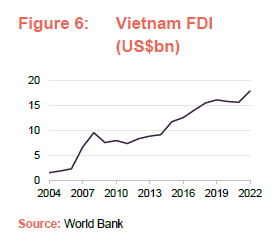
Investment process
Dynam Capital is searching for high-growth, compounding businesses that it can hold for the long-term.
In managing VNH’s portfolio, Dynam Capital (dynamcapital.com) is looking for high-growth, compounding businesses that it can hold for the long term. This can be summarised as growth at an attractive valuation. Dynam manages its portfolios using a mixture of top-down and bottom-up investment strategies. The top-down element of the investment process guides the manager towards the key sectors and sub-sectors on which to focus its attention, with the aim of achieving superior long-term returns. The bottom-up element of the process uses extensive fundamental research to select the best companies in those sectors and sub-sectors.
ESG incorporated into all investment and monitoring procedures
ESG research is fully integrated into its investment process.
ESG criteria are central to Dynam’s approach and have been part of its DNA since the beginning. Vu Quang Thinh, Dynam’s chief investment officer (CIO), is very well-regarded in this area. He is a founding member and former chairman of the Vietnam Institute of Directors (VIOD). Established in April 2018, VIOD was the first private and independent organisation in Vietnam, aimed at promoting the highest standards and best practices in corporate governance among domestic firms.
Four-stage investment process: internal screening, due diligence, investment decision and investment monitoring
Dynam’s investment universe comprises around 1,500 companies split across three exchanges in Vietnam (the two major exchanges are Ho Chi Minh City and Hanoi), with a combined market capitalisation in the region of US$200bn. The overwhelming majority of these are deemed to be not suitable for investment. Many are too small, and others will not fit Dynam’s ESG criteria.
The initial screening process reduces the investable universe to around 150 companies. Further analysis reduces this to around 70, on which Dynam speaks to company management and conducts extensive due diligence. Ultimately, this is narrowed to a portfolio of around 23 that fully reflects Dynam’s philosophy.
Internal screening and due diligence
Dynam regularly screens the Vietnamese market against its investment screening criteria to identify new potential investments. This includes an assessment against the manager’s critical risk table and its initial ESG checklist. Companies that pass this phase undergo a concept discussion at the weekly team meeting. If they pass, they enter the investment pipeline.
Of the 70 or so companies that make it through the initial screening phase and enter Dynam’s investment pipeline, the manager conducts extensive due diligence to assess a company’s suitability for inclusion in Dynam’s portfolios.
In this phase, a company is assessed in detail against Dynam’s investment criteria (see below). The manager conducts site visits, interviews company management, scores the company against its ESG matrix in greater depth, and builds a detailed valuation model. Broker reports and sector reviews feed into this process. Dynam’s investment criteria can be summarised as follows:
- Compounding long-term earnings-per-share (EPS) growthZ (approximately 20% per annum);
- Attractive valuation with built in safety margin;
- Strong balance sheet and cashflow management;
- Rigorous adherence to ESG principles;
- Industry leader with strong competitive position; and
- Best management teams amongst peers.
The due diligence process is fully documented and conclusions of all of this analysis are pulled together into a draft investment proposal, which is presented to the investment team. The investment team critically appraises the proposal, and it is revised based on their feedback. Assuming that an investment clears this stage, the investment proposal is then finalised.
Investment decision and monitoring
Once an investment proposal has been finalised, it is reviewed by the investment committee at its weekly meeting and, where appropriate, the client. Assuming that an investment receives approval, it is passed to the trading team for execution.
Investment monitoring may lead to company engagement to propose improvements or suggest remedial action.
Dynam operates a process of ongoing investment monitoring. This includes attending analyst meetings, regular company visits, reviewing results and periodically rescoring a company against Dynam’s ESG matrix. Following such an event, an internal update on the company is produced and this is reviewed by the investment committee. Where appropriate, this may lead to company engagement, to propose improvements or suggest remedial action. It may also lead to a divestment proposal, which is also reviewed by the investment committee, before being acted thereon.
Investment restrictions
VNH’s articles of association impose the following investment restrictions, VNH:
- will not invest more than 10% of its NAV (at the time of investment) in the shares of a single investee company;
- will not invest more than 30% of its NAV (at the time of investment) in any one sector;
- will not invest directly in real estate or real estate development projects. However, it may invest in companies that have a large real estate component, if their shares are listed or are traded on the over-the-counter (OTC) market;
- will not invest in any closed-ended investment fund unless the price of such investment fund is at a discount of at least 10% to its prevailing net asset value (at the time of investment);
- may invest up to 25% of its NAV (at the time of investment) in companies with shares traded outside of Vietnam, if a majority of their assets and/or operations are based in Vietnam;
- may invest up to a maximum of 20% of its NAV (at the time of investment) in direct private equity investments;
- may invest up to 20% of its NAV (at the time of investment) in other listed investment funds and holding companies which have the majority of their assets in Vietnam;
- may borrow money, and grant security over its assets, provided that such borrowings do not exceed 25% of the latest available NAV (at the time of the borrowing);
- may also invest in securities that have equity features, such as bonds that are convertible into equity;
- may also invest its available cash in domestic bonds or international bonds issued by Vietnamese entities; and
- may utilise derivatives contracts for both hedging purposes and efficient portfolio management, but it will not utilise derivatives for investment purposes.
Investment restrictions – based on the United Nations Principles for Responsible Investment
VNH is a signatory of the UNPRI.
VNH is a signatory of the United Nations Principles for Responsible Investment (UNPRI). This imposes a number of ESG-related restrictions. As a signatory, it will not invest in companies:
- known to be significantly involved in the manufacturing or trading of distilled alcoholic beverages, tobacco, armaments or in casino operations or other gambling business;
- known to be subject to material violations of Vietnamese laws on labour and employment, including child labour regulations or racial or gender discriminations; or
- that do not commit to reducing, in a measurable way, pollution and environmental problems caused by their business activities.
Asset allocation
Concentrated and low turnover portfolio of Vietnamese stocks
As at 31 October 2023, VNH’s portfolio had exposure to 26 securities, an increase of three from the 23 securities that it held at the end of April 2023 (the most recently available data when we last published). As we have previously observed, VNH’s portfolio is highly concentrated; it typically has exposure to between 20 and 25 securities (an average position size of between 4% and 5%), but actual position sizes can vary quite markedly (depending on valuation and the manager’s level of conviction). As illustrated in Figure 12, the top 10 holdings accounted for 61.5% of VNH’s portfolio as at 30 April 2023, which is a noticeable decrease in concentration from the 66.4% six months earlier.
Distinctly different from the index
VNH’s portfolio has a high active share.
VNH’s portfolio is distinctly different from the VN All-Share (or any Vietnamese-focused exchange-traded-fund (ETF) for that matter). VNH’s portfolio has a high active share – typically 75-80% – and it should be noted that the index does not benefit from the manager’s strong focus on ESG considerations. Reflecting this, VNH has provided long-term outperformance of the main Vietnamese market indices (see Figure 19 on page 19) and its peers (see the peer group performance section on page 21).
Deploying cash to take advantage of opportunities
While VNH is permitted to borrow (up to 25% of its net assets), in practice, it does not have any debt facilities in place and generally maintains a small cash balance that is sufficient to meet its operating requirements. When we last published in June 2023, we commented how the manager had been taking a relatively conservative approach to managing the portfolio, holding a higher cash balance both to take advantage of opportunities thrown up by volatility in the market and to provide some downside protection as the manager saw a number of macro and political risks.
Moving into the second half of this year, the manager has been deploying this cash, increasing allocations to good stocks that had de-rated, including reallocating back into real estate, which had been reduced significantly in the first half. It thinks that developers in affordable housing were oversold and well positioned in the current environment, so added to names such as Nam Long and Khang Dien House (see pages 17 and 16 of our December 2022 note respectively).
Figure 7 shows VNH’s month-end cash balance, as a proportion of net assets over the last five years. It illustrates that the cash level is not static and moves as the manager adjusts the portfolio to take advantage of prevailing opportunities. Having risen during the first half of this year, VNH’s cash balance has returned to a more natural level of 2-3%.
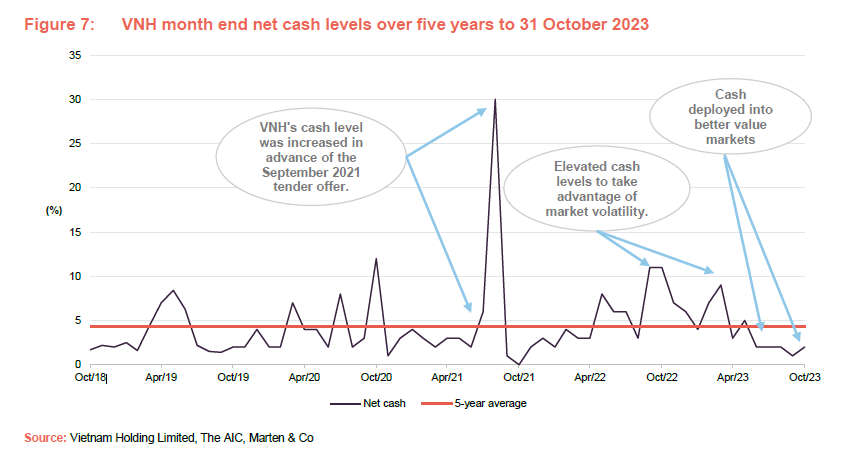
Rotating exposure to the banking sector
When we last published, we commented how VNH’s manager had been restructuring the portfolio’s exposure to the banking sector to reflect a less certain economic environment, shifting away from what it describes as the more aggressive pro-cyclical banks into more stable defensive opportunities. This process has continued with the banking exposure edging up by two percentage points and, as illustrated in Figure 12, five of the top 10 holdings are now banking positions (previously it was four), with Asia Commercial Bank (discussed below) a new entrant into the top 10. Otherwise, the key changes have been an increase in the allocation to Vietcombank (this has been a significant positive contributor to VNH’s recent performance) and reductions in the allocations to VP Bank and MB Bank (this is still a top five holding).
VP Bank and MB Bank are smaller banking operations and have greater exposure to mortgage lending than some of their peers, meaning that they are more vulnerable to rising interest rates. However, VNH’s manager expects the banks to benefit as the economy expands again and will likely add to its banks’ position in the future, although VNH will tend to be underweight banks as these currently accounts for around 38% of the index and VNH’s exposure to any one sector is limited to 30%. Nonetheless, the manager expects Vietcombank to post EPS growth of around 20% in 2024. The manager also notes the high level of internet penetration in Vietnam (there are more Facebook accounts than bank accounts) and expects growth in the banking sector will be digitally enabled.
The manager has also added to financial services at the margin – with exposure increasing by four percentage points, while exposure to real estate has continued to edge down – by two percentage points.
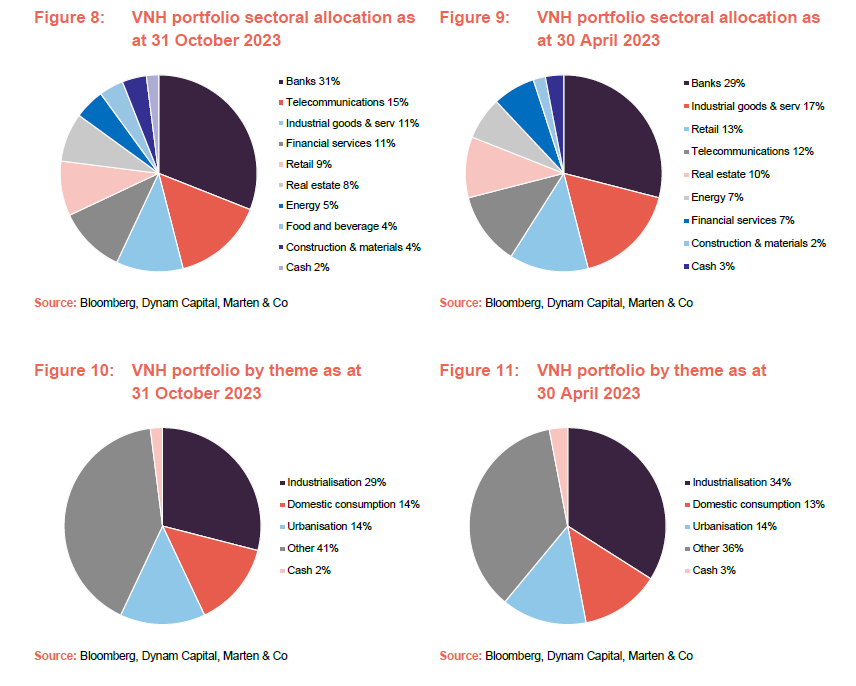
The shift in exposure to industrial goods and services is the largest move – a reduction of five percentage points, reflecting the manager’s decision to allocate to more defensive sectors (those that are less economically sensitive).
Top 10 holdings
Figure 12 shows VNH’s top 10 holdings as at 31 October 2023, and how these have changed since 30 April 2023 (the most recently available data when we last published). Reflecting its longer-term low turnover approach, eight of the top 10 holdings as at 31 October 2023 were constituents of VNH’s top 10 at the end of April 2023, with FPT Group and Sacombank continuing to hold the number one and two spots respectively. Holdings that have moved up in to the top 10 are Asia Commercial Bank and VP Bank, while Vietin Bank and Hoa Phat Group have moved out.
We discuss some of the more interesting developments in the next few pages. However, readers interested in more detail on these top 10 holdings, or other names in VNH’s portfolio, should see our previous notes (see page 29 of this note for a link).
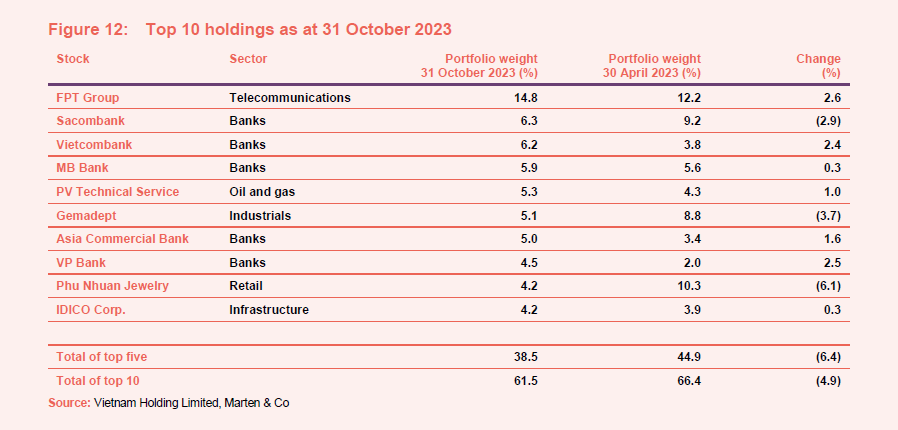
FPT Group (14.8%) – investing with the godfather of deep learning
FPT is the largest IT services company in Vietnam, is a long-term holding for VNH and has been VNH’s largest holding for some time (we last commented on it in our June 2023 note and, prior to that March 2021 – see page 30 of this note). FPT develops software, provides IT and telecom services (including broadband internet), and is a distributor/retailer of IT and communication products. The company employs the largest software engineer workforce in Vietnam and offers outsourcing services to more than 650 global customers and partners. It has been benefiting from a robust order pipeline, particularly from US and Japanese companies and the software outsourcing business continues to do very well (it benefits from competitive labour costs versus India and China).
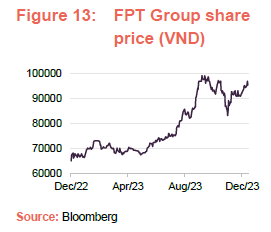
VNH’s manager is excited by the opportunities it expects to see opened up by the recently announced strategic partnership with Landing AI in the Asia Pacific region. Landing AI is a leading artificial intelligence (AI) software company whose founder and CEO is Dr Andrew Ng, who the manager describes as ‘the godfather of deep learning’. Dr Ng also founded and led the Google Brain project and was previously the chief scientist at Baidu. The partnership is expected to drive the application and education of AI in Vietnam (in areas such automotive, manufacturing, healthcare, and education, for example), leveraging the company’s experience in the US market.
Gemadept (5.1%) – re-rated by market as earnings recovered
Gemadept Corporation (gemadept.com.vn) is a marine freight transportation company that owns and operates ports and provides related logistics activities, both in Vietnam and internationally. This includes containers and oversize freight, as well as transportation by deep sea, inland water, land and air. The company also owns around 30% of Saigon Cargo Services (or SCS, another VNH holding which we discussed in previous notes), which is the leading air cargo terminal operator at Ho Chi Minh City’s Tan Son Nhat airport (its services include customs paperwork, security screening, packing, storing and airfreight consolidation). We last discussed Gemadept in our June 2023 note (see page 30) where we explained that, as the lowest cost port operator, the company is well-positioned to benefit from growing FDI and international trade.
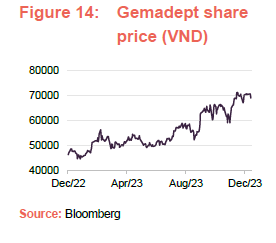
As is illustrated in Figure 14, Gemadept shares have benefited from a strong recovery during the last year, making them a key positive contributor to VNH’s recent performance. Port volumes globally were impacted by the zero-COVID policy in China and western sanctions against Russia, which saw the company post negative earnings growth of 23% for the year ended 31 December 2022. However, the company took action, selling Nam Hai Dinh Vu, a mature port asset in the north of the country with modern facilities and equipment, which strengthened its balance sheet and gave it the cash to invest in less developed parts of the business. The company has also benefited as China’s economy has continued to re-open and the air side of the business has seen a recovery in travel and tourism. The company reported pre-tax profits of VND1.71trn for Q2 2023 – a five-fold increase on the same period for the prior year – and the market has re-rated it strongly.
VNH’s manager says that Gemadept is well positioned to consolidate other assets in the country and has shifted the dial on ecoports in Vietnam. The manager says it is running at very good capacity levels and, with cash on the balance sheet to build out the portfolio, it expects to see strong growth, higher return on equity (ROE) and higher return on invested capital (ROIC). The company will also benefit from an uplift in port handling charges next year. On the reporting side, Gemadept is measuring its profits quarterly and following international standards and has improved its investor relations significantly in recent years – for example, it now does site visits and investor presentations.
Asia Commercial Bank (5.0%) – Vietnam’s largest private bank
Asia Commercial Joint Stock Bank (acb.com.vn/en), more commonly known as Asia Commercial Bank or ACB, is the largest private bank by assets in Vietnam. It employs over 13,000 people, has a network of 90 branches and 249 sub-branches spread across 49 provinces in Vietnam. ACB is focused primarily on the retail banking segment which comprises more than 60% of its loans and 80% of deposits (source: Fitch Ratings). The bank also focuses on lending to small and medium sized enterprises (SMEs).
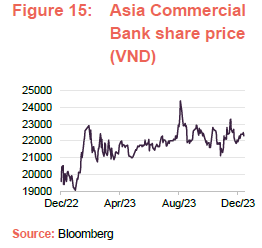
VNH’s manager describes Asia Commercial Bank as being a very conservatively run bank that has been operating its strategy consistently for a long time (ACB was founded just over 30 years ago in 1993). While lending to households and SMEs is traditionally more exposed in a difficult economic environment, VNH’s manager is confident that ACB can navigate the current challenges and should emerge stronger, allowing it to grow at a clip as the market recovers. The manager says that ACB benefited from having Standard Chartered and Jardines as strategic partners during the early stages of its development, putting ACB on a strong footing in terms of its business practices and reporting.
The manager comments that it is difficult to acquire stock in ACB as it is at its FOL, so it has been picking up lines where it can at sensible prices to gradually build a position (ACB has been typically trading at around a 7% premium to the domestic price with no known seller). Fitch reaffirmed the bank’s credit rating at BB- with a stable outlook.
PV Technical Service (5.3%) – partnering with Sembcorp
PV Technical Services (ptsc.com.vn), sometimes referred to as PVS, or more formally PetroVietnam Technical Services Corporation, provides an extensive range of technical services for the oil & gas, energy and industrial sectors (see pages 12 and 13 of our June 2023 note for more details). It is 51.38% owned by Vietnam Oil and Gas Group, and has operations in Vietnam, Singapore and Malaysia. As detailed in our June 2023 note, VNH’s manager has identified PV Technical Services as being well-positioned to benefit from the energy transition, particularly now that the Vietnamese government has published PDP8, which has a big focus on renewables. This includes offshore wind generation, onshore wind generation and solar PV. PVS, with its long history of offshore drilling services and fleet of tugs and equipment, will play a pivotal role in the development of offshore wind generation in Vietnam.
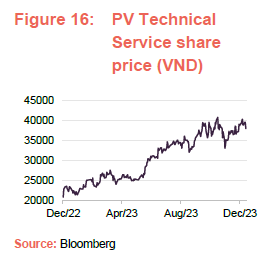
In our last note, we explained how PVS was advantageously positioned to play a major role a proposal to build an 800km long undersea cable between Vietnam and Singapore. In October 2023, Singapore granted conditional approval to Sembcorp (a subsidiary of the global investment company Temasek Holdings) to import 1.2GW of low-carbon electricity from Vietnam (this will be predominantly generated by offshore wind) and Sembcorp has selected PVS as a development partner.
Phu Nhuan Jewelry (4.2%) – derated on difficult outlook for consumer
Phu Nhuan Jewelry (www.pnj.com.vn), also referred to as PNJ has long been a significant position within VNH’s portfolio (we most recently discussed it in our June 2023 note – see pages 21 and 22 of that note). PNJ is the leading jewellery manufacturer in Vietnam and its operations cover the full value chain. The company has expanded its production capacity in recent years (from 4m units in 2019 to 6m today) but it has been operating significantly below the maximum.
PNJ is an example of a consumer stock that benefits from a growing middle class in Vietnam. As their income grows, consumers tend to move up the value chain in search of better quality and, with a product range that covers the mid-end to luxury jewellery segments, VNH’s manager believes that PNJ is in a strong position to benefit from this long-term trend. However, the holding has been a significant detractor from recent performance with its share price derating heavily in the first half of 2023, reflecting a deteriorating outlook for consumers (it is a similar story for other retail holdings such as Mobile World and FRT). However, the manager added to the position in the second half and VNH has benefited as the share price has recovered; it thinks that the long-term fundamentals for the business remain intact.
Performance
An obvious feature of Figure 19, which shows up in the three-month returns, is the Vietnamese market correction during September and October. Regardless, VNH’s NAV and share price and NAV total returns are ahead of all of the local marked indices and the peer group for all of the periods in Figure 19 with the exception of the really short-term one- and three-month periods. However, we continue to think that the longer-term time frames are better for assessing a longer-term growth strategy such as VNH’s and Figure 19 shows that VNH has markedly outperformed all of the local indices and its wider peer group over the long-term (there is more on VNH’s performance versus peers in the next section).
Key contributors to performance YTD have been Gemadept, which benefited from a strong re-rating by the market; and the manager’s decision to rejig VNH’s exposure to the banking sector – reducing the positions in MB Bank and VP Bank as it felt that these were more exposed to the mortgage market where the environment was becoming tougher, and reallocating into positions such as Vietcombank which are more exposed to areas such as insurance and wealth management.
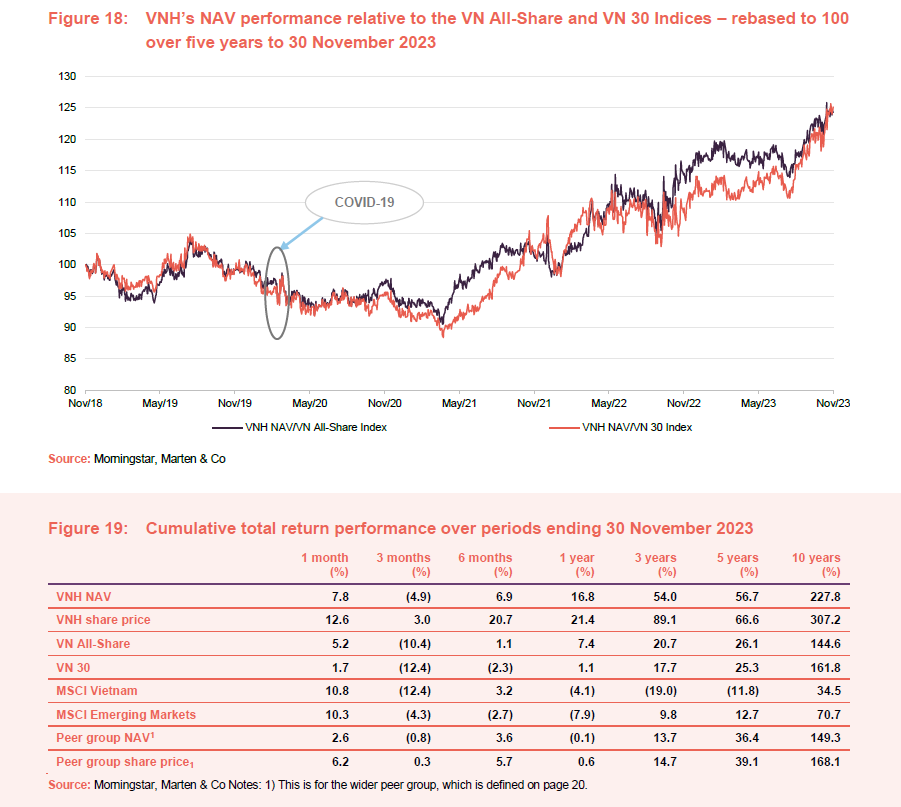
Peer group
VNH is a member of the AIC’s Country Specialist sector which comprises three funds focused on Vietnam as well as Weiss Korea Opportunity, a fund focused on Korean preference shares. Consistent with our previous notes, our peer group analysis takes a more comprehensive approach whereby we compare VNH against both a direct peer group that focuses on the three pure Vietnam funds as well as a broader comparison that includes other single country funds from the wider Asia Pacific region. These were all previously peers of VNH when it was part of the Country Specialist: Asia Pacific-ex Japan sector that was discontinued at the end of March 2021.
Please click here for an up-to-date peer group comparison of VNH versus its Country Specialist peers.
As illustrated in Figure 20, VNH is the top performing fund in the direct peer group of pure Vietnamese funds, in NAV total return terms, over almost all of the periods provided. Interestingly, VNH has outperformed VEIL, which is also focused on listed equities, over all of the time frames and while it has also tended to outperform VOF in recent years, VNH is also one of the top-performing funds in the wider peer group.
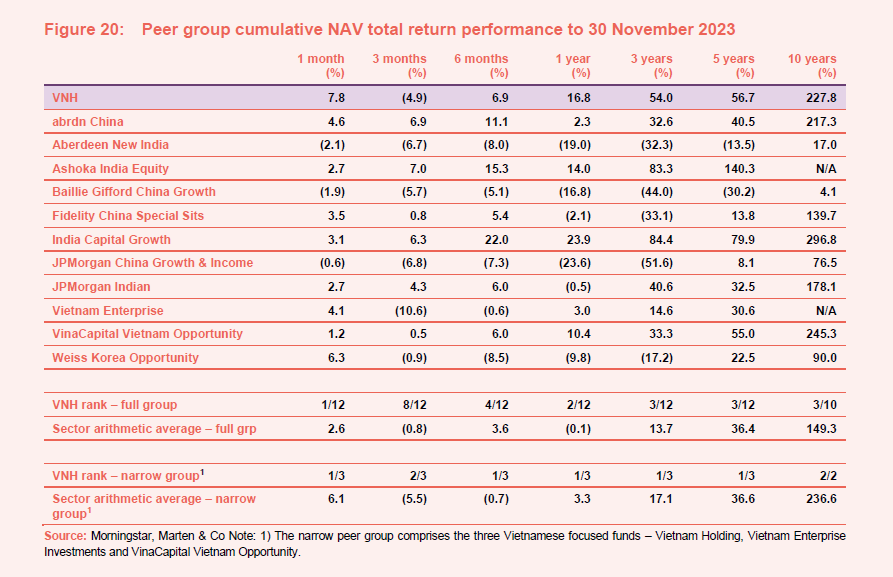
VNH’s 10-year returns are fractionally below the average but changes made to VNH’s structure from September 2017 have benefited shareholders (see our December 2019 initiation note for more details – and page 30 of this note).
A comparison of the narrower and wider peer group averages illustrates why investors may wish to consider having a direct exposure to Vietnam. The average returns from the narrower group of Vietnamese funds exceed that of the broader peer group for all of the long-term time frames.
Looking at Figure 21, a similar pattern is seen in VNH’s share price total return performance against both its wider and direct peer group, although VNH is the top performing fund within its narrow peer group over all the periods provided. This reflects the discount narrowing that VNH has benefited from over the longer-term (see page 23).
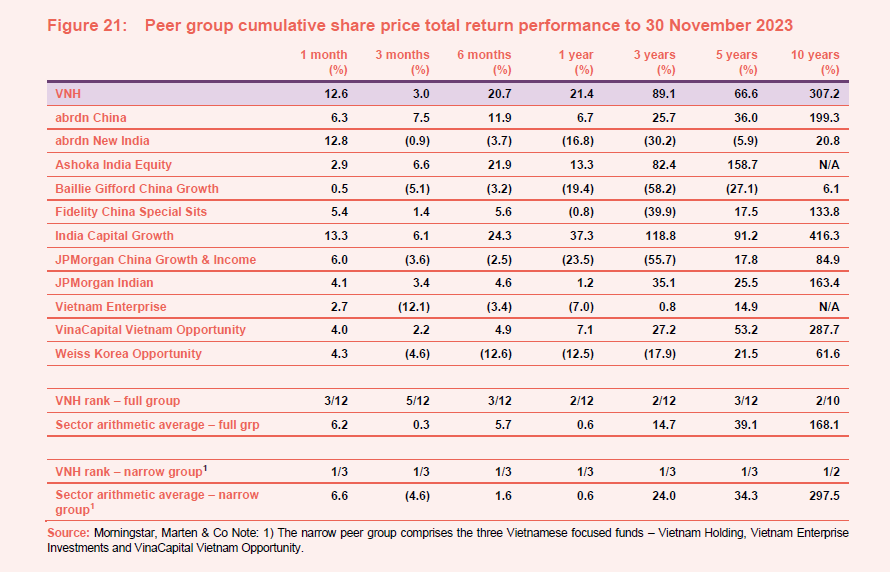
Looking at Figure 22, the volatility of VNH’s NAV returns is middle of the range for its Vietnam focused peers although, of the wider peer group, it is one of the widest. However, it should be noted that for the majority of the five years over which this NAV volatility has been calculated, abrdn China and Baillie Gifford China Growth (BGCG) have operated with markedly different strategies. abrdn China was Aberdeen New Thai (before its merger with Aberdeen Emerging and the accompanying change of strategy), while BGCG was Witan Pacific (this operated a multi-manager funds of funds approach, which is inherently more diversified, and therefore likely to exhibit lower volatility than a more focused single country fund, but returns are similarly diversified – it was Witan Pacific’s ongoing underperformance that saw the change of mandate and investment manager).
At 3.07%, VNH has the highest ongoing charges ratio, both for the wider peer group and for the three Vietnamese-focused funds. The higher-than-average ongoing charges ratio does in part reflect its relatively-small size. However, it is notable that while VNH’s ongoing charges ratio is 117 basis points (bp) (equivalent to1.17%) higher than VEIL’s, VEIL is a significantly larger fund (VEIL’s market cap is 12.7x that of VNH) and VNH’s higher running costs seem to be more than compensated for by its superior performance (which is after fees and expenses). Like the majority of the funds in the wider peer group, VNH does not charge a performance fee. Of its direct peers, VOF charges a performance fee, while VEIL does not.
Like many funds in the sector, VNH does not pay a dividend reflecting both its capital growth focus and the underlying market in which it invests. In terms of gearing (borrowing), whilst VNH is permitted to borrow, the managers have chosen not to and, instead, to maintain a modest cash balance that is sufficient to meet its ongoing cash needs. All of the Vietnam-focused funds tend to run with a net cash position to some degree. VNH has the lowest level of net cash within both its direct and wider peer groups, although it regularly has the highest.
No dividend – capital growth focused
VNH does not have a formal dividend policy and has not paid a dividend since its launch. As a Guernsey-domiciled investment company, there is no requirement to pay out a minimum of 85% of its net revenue income that would apply if it was a UK-domiciled investment trust. During the year ended 30 June 2023, VNH earned dividend income of US$1.68m (2022: US$1.81m), which is equivalent to USc5.87 per share (2021: USc5.66 per share).
VNH is not required to pay a dividend and has not paid one since launch.
Total income fell again during the last financial year, which is in part a reflection of the additional contraction of VNH’s asset base from further share repurchases (see next section). However, it is noteworthy that income per share has risen once again, which reflects further recovery as the region has re-opened following COVID.
Premium/(discount)
VNH’s discount has moved within quite a clearly defined range during the last 18 months. Figure 23 illustrates a number of key events that have influenced the discount to NAV in recent years, and we recommend readers see our previous notes for more details of those (see page 30).
As at 13 December 2023, VNH was trading at a discount to NAV of 7.1%, which is a one-year low (one-year range: 7.1% to 19.6%) and narrower than its long-term averages (one-, three- and five-year averages of 14.2%, 15.3% and 16.6% respectively). We think reflects a positive reaction by the market to the recently announced proposals for an annual redemption facility (detailed below).
Given the extent of the Vietnamese growth story and VNH’s long-term trend of outperformance of its peers and Vietnamese equity markets, we think that there is potential for the discount to NAV to tighten further, particularly as recent headwinds to the Vietnamese market subside. Given the additional certainty offered by the proposed redemption facility, there is the potential that the discount to NAV could narrow sufficiently to allow VNH to issue stock and grow again, which would be to the benefit of all shareholders.
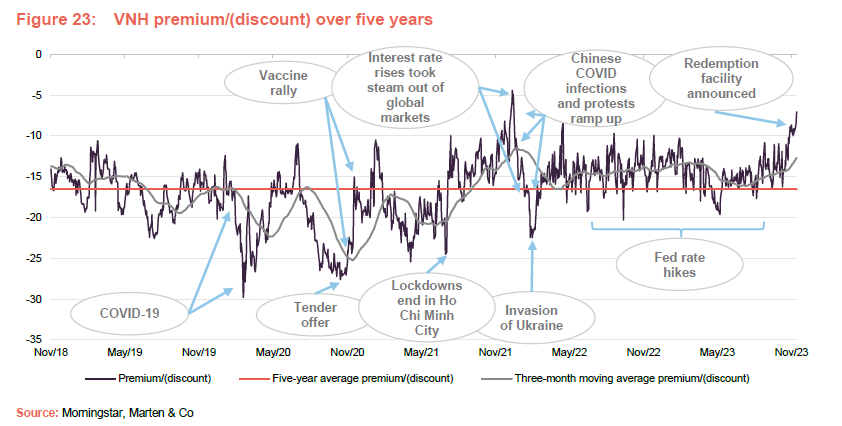
Discount control – new annual redemption facility
VNH has an active discount control policy.
VNH is authorised to repurchase up to 14.99% and allot up to 10% of its issued share capital, as well as having an active discount control policy that seeks to address the imbalance between the supply of and demand for its ordinary shares (this process is overseen by VNH’s broker, Cavendish, and is monitored by the board).#
VNH has returned over US$150m through buybacks and tenders during the last five years.
VNH has provided bi-annual tender offers for a number of years: the last was a 15% tender offer at the beginning of November 2021, which was taken up by most shareholders and was conducted at a 2% discount to NAV (see pages 27 and 31 of our March 2021 note for more details). VNH has returned over US$150m to shareholders through buybacks and tenders during the last five years.
VNH’s board is proposing that shareholders be offered an annual opportunity to realise their holdings at fair market value through a redemption facility. The board believes that this facility, which will be at its discretion, will lead to a narrower discount to NAV over time. The proposals require shareholder approval, and an extraordinary general meeting (EGM) is being convened on 21 December 2023, immediately after the annual general meeting (AGM). If the proposals are approved, the first redemption point is expected to be on 30 September 2024.
The board has identified a number of benefits to shareholder from the proposals, which are listed as follows:
- the establishment of a mechanism by which shareholders may be able to dispose of some or all of their shareholding, should they wish to do so, which is not dependent on the market liquidity of the ordinary shares;
- an additional mechanism to allow VNH to seek to address, through share redemptions, buybacks and new issuance from time to time, market imbalances in the supply of, and demand for, the ordinary shares;
- minimising the discount at which the ordinary shares trade compared to NAV per ordinary share; and
- an uplift in NAV per ordinary share for VNH and continuing shareholders as a result of a redemption charge applied when ordinary shares are redeemed after being held for less than 2 years.
Fees and costs
Tiered management fee structure with no performance fee
Tiered base management fee starting at 1.75% of net assets per annum and reducing.
Dynam Capital is entitled to receive a basic management fee of:
- 75% per annum of net assets up to US$300m;
- 50% per annum for net asset in excess of US$300m up to US$600m; and
- 1% of net assets in excess US$600m.
The management fee is paid monthly in arrears, and the management agreement can be terminated on six months’ notice by either side. There is no performance fee element. The ongoing charges ratio for the year ended 30 June 2023 was 3.07% (2022: 2.74%; 2021: 2.52%) which looks high relative to peers and the typical investment company.
Part of the reason for the rise in the ongoing charges ratio has been the shrinkage in assets under management (AUM) that has resulted from the tender offer in late 2021 and subsequent repurchases that the board has authorised to try and address supply and demand imbalances, with the result that VNH is spreading its fixed costs over a smaller asset base, which puts upward pressure on the ongoing charges ratio. If the redemption opportunity succeeds in narrowing the discount, and the company is able to expand, the ongoing charges ratio should fall to a more acceptable level.
Fund administration and company secretarial services
Sanne Group (Guernsey) Limited is VNH’s administrator and company secretary. The administrator receives a fee of 0.08% per annum for of net assets up to US$100m and 0.07% per annum for net assets in excess of this, subject to a minimum fee of US$140k per annum. The administration fees are accrued monthly and are payable quarterly in advance. VNH has also entered into a separate accounting services agreement with the administrator. The combined administration and accounting fees fell by 7.1% to US$201.6k for the year ended 30 June 2023 (2022: US$216.9.3k).
Custody and audit fees
Standard Chartered Bank (Singapore) Limited and Standard Chartered Bank (Vietnam) Limited are VNH’s custodian and the sub-custodian respectively. Custodian fees are charged at 0.08% on the assets under administration (AUA) per annum, subject to a minimum of US$12,000 per annum. Safekeeping of unlisted securities is charged separately at US$12,000 per annum for up to 20 securities (2022: US$12,000). KPMG Channel Islands Limited is VNH’s auditor and audit fees were up by 11.1% to £62,200 for the year ended 30 June 2022 (2022: £56,000).
Capital structure and life
VNH follows an ungeared strategy.
VNH has a simple capital structure with one class of ordinary share in issue. It is also permitted to borrow up to 25% of its net assets, although, in practice, VNH does not have any debt facilities in place and maintains a small cash balance that is sufficient to meet its operating requirements. VNH’s ordinary shares have a premium main market listing on the London Stock Exchange and, as at 13 December 2023, there were 27,363,684 of these with voting rights in issue with none held in treasury.
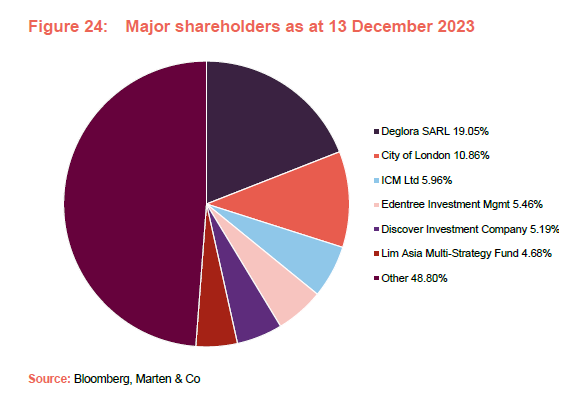
Unlimited life; continuation vote at December 2023 AGM
VNH does not have a fixed winding-up date. Shareholders approved a resolution for VNH to continue for a further five years at the 2018 AGM, and the next continuation vote is scheduled for its AGM on 21 December 2023.
Financial calendar
VNH’s year end is 30 June. The annual results are usually released in September/October (interims in March) and its AGMs are usually held in October/November of each year.
Management team
Since 2017, VNH has been managed by Vietnam specialist Dynam Capital and prior to that was managed by Vietnam Holding Asset Management (VNHAM).
More information on the manager can be found at its website:
www.dynamcapital.com
Dynam is a partner-owned business whose sole focus is asset management in Vietnam. Its investment strategy is based on fundamental research, with a strong focus on companies that have a strong commitment to ESG principles. Vu Quang Thinh and Craig Martin (see biographies below) are both executive directors and founding partners of Dynam. The lead portfolio manager is Nguyen Hoang Thanh (see biography overleaf). He is supported by a portfolio analyst, a data analyst and a trader.
Vu Quang Thinh (CIO and managing director of Dynam Capital)
Vu Quang Thinh has over 30 years’ business experience, including 15 years in asset management, 12 years in corporate restructuring and seven years in an information technology business. He joined VNHAM in 2011 as chief executive officer (CEO) and, he was appointed to the board of VNHAM in 2014.
Before joining VNHAM, Thinh served as chief executive officer of a local asset management company. Previously, he was managing partner of MCG Management Consulting, which he founded. Prior to this, he was head of the management consulting practice of KMPG Vietnam where he did extensive restructuring work with several state-owned enterprises.
Thinh holds an MBA from Washington State University and a BS degree in Mathematical Economics from Hanoi National Economic University. He is a Certified Asset Management Practitioner in Vietnam. As noted on page 10, he is a founding member and former chairman of the Vietnam Institute of Directors (VIOD).
Craig Martin (chairman of Dynam Capital)
Craig Martin has over 26 years’ investment and fund management experience in emerging markets. He has lived and worked in Southeast Asia since 1993. This includes seven years in Cambodia, five years in Vietnam and 13 years in Singapore.
Until early 2018, Craig was co-CEO of CapAsia, a Singapore headquartered private equity fund manager, focusing on investments in Asia’s emerging markets. He joined CapAsia in 2010, and served on the boards of companies in Thailand, Malaysia, Philippines, Vietnam, Singapore, Indonesia and Pakistan. Prior to CapAsia, Craig was head of private equity for Prudential Vietnam (now Eastspring), and he was previously part of the founding management team at Standard Chartered Private Equity.
Craig has a Masters degree in Engineering from the University of York and a MBA with Distinction from INSEAD. He is also a member of the Singapore Institute of Directors. Craig is also a non-executive director of several private companies.
Craig has a significant personal investment in VNH.
As at 13 December 2023, Craig has a personal investment in VNH of 67,086 shares, representing 0.25% of VNH’s issued share capital. He added 7,400 shares to his holding during the last financial year. As a Singaporean National, Craig is able to purchase and hold VNH shares, although the same is not true for other members of the management team, who are Vietnamese nationals, as they are not permitted to own foreign investments. This includes VNH as it is domiciled in Guernsey.
Nguyen Hoang Thanh (portfolio manager)
Nguyen Hoang Thanh has over 10 years of experience in banking and finance in Vietnam, including eight years in asset management and more than two years in banking. He started his career at LienVietPostBank, as a corporate banking officer, before joining Vietnam Holding Asset Management in 2011 as an analyst (he was promoted to manager in 2014). Thanh then spent one year at Dragon Capital as a senior banking analyst, and in late 2017, he worked at Pavo Capital as a Senior Investment Manager covering IPOs and pre-listing investment opportunities. He holds a Masters degree from Clark University, Massachusetts, and a BA in Finance from Can Tho University, Vietnam. He is also a CFA charterholder.
Board
VNH’s board has an average length of service of 5.9 years.
VNH’s board is comprised of five directors, all of whom are non-executive and considered to be independent of the investment manager. Other than VNH’s board, its directors do not have any other shared directorships. Board policy is that all of VNH’s board members retire and offer themselves for re-election annually. VNH has adopted a formal policy that neither the chairman nor any other director shall serve for more than nine years. The board will therefore need to give thought to succession planning in the next few years although, with an average length of service of 5.9 years, this is not a pressing issue.

Directors’ fees
VNH’s articles of incorporation limit the aggregate directors’ fees to a maximum of US$350k per annum. The total directors’ fees for the year ended 30 June 2023 was US$270,901 (2022: 270,185), which is well within the US$350k limit.
Recent share purchase and disposal activity by directors
None of the directors have made any purchases or sales of shares during the last 12 months.
Hiroshi Funaki (chairman)
Hiroshi Funaki has been actively involved in raising, researching and trading Vietnam funds for 23 years. Previously, he worked at Edmond de Rothschild Securities (between 2000 and 2015) where he led the Investment Companies team, focusing on Emerging Markets and Alternative Assets. Prior to that, he was head of research at Robert Fleming Securities, also specialising in closed-end funds. He currently acts as a consultant to a number of emerging market investors.
Hiroshi has a BA in Mathematics and Philosophy from Oxford University, and is a UK resident. He became chairman at the conclusion of VNH’s AGM on 8 November 2019, taking over the position from Sean Hurst.
Philip Scales (chairman of the audit and risk committee)
Philip Scales has over 40 years’ experience working in offshore corporate, trust, and third-party administration. For 18 years, he was managing director of Barings Isle of Man (subsequently to become Northern Trust), where he specialised in establishing offshore fund structures, latterly in the closed-ended arena (both listed and unlisted entities). He subsequently co-founded IOMA Fund and Investment Management Limited (now named FIM Capital Limited), where he is deputy chairman. Philip is a Fellow of the Institute of Chartered Secretaries and Administrators, and holds a number of directorships of listed companies and collective investment schemes. He is an Isle of Man resident.
Sean Hurst (senior independent director)
Sean Hurst was co-founder, director and chief investment officer of Albion Asset Management, a French regulated asset management company, from 2005–2009. He is an experienced multi-jurisdictional director, including roles at Main Market and AIM traded funds and numerous offshore and UCITS funds. In addition to advising companies on launching both offshore and onshore investment funds, he is currently non-executive chairman of JPEL Private Equity Ltd and a non-executive director at CIAM Opportunities Fund and Satellite Event Driven UCITS Fund. Sean was formerly a non-executive director of AIM listed ARC Capital Holdings Ltd. He holds an MBA in Finance from CASS Business School and is a resident of France.
Damien Pierron (director)
Damien Pierron is currently managing director at Société Générale in Dubai, where he heads the coverage for Family Offices and Wealthy Families in Middle East and Russia. He has 15 years’ experience in M&A, private equity, equity derivatives, wealth management and investment banking gained at, among others, Lafarge Holcim, OC&C Strategy Consultants and Natixis. Damien is a CFA charterholder and holds a Degree in Mathematics, Physics and Economy from École Polytechnique in Paris. He also holds a Masters Degree in Quantitative Innovation from École Nationale Superieure des Mines de Paris. He is a Dubai resident.
Saiko Tajima (director)
Saiko Tajima has over 20 years’ experience in finance, including eight years spent in Asian real estate asset management and structured finance. She has worked for Aozora Bank and group companies of both Lehman Brothers and Capmark, where she focused on financial analysis, monitoring and reporting to lenders, borrowers, auditors, regulators and rating agencies. Over the last five years, she has invested in and helped develop tech start-ups in Tokyo, Seoul and Sydney.
Previous publications
Readers interested in further information about VNH may wish to read our previous notes (details are provided in Figure 26 below). You can read the notes by clicking on them in Figure 26 or by visiting our website.
Figure 26: QuotedData’s previously published notes on VNH
Source: Marten & Co
IMPORTANT INFORMATION
Marten & Co (which is authorised and regulated by the Financial Conduct Authority) was paid to produce this note on Vietnam Holding Limited.
This note is for information purposes only and is not intended to encourage the reader to deal in the security or securities mentioned within it.
Marten & Co is not authorised to give advice to retail clients. The research does not have regard to the specific investment objectives financial situation and needs of any specific person who may receive it.
The analysts who prepared this note are not constrained from dealing ahead of it but, in practice, and in accordance with our internal code of good conduct, will refrain from doing so for the period from which they first obtained the information necessary to prepare the note until one month after the note’s publication. Nevertheless, they may have an interest in any of the securities mentioned within this note.
This note has been compiled from publicly available information. This note is not directed at any person in any jurisdiction where (by reason of that person’s nationality, residence or otherwise) the publication or availability of this note is prohibited.
Accuracy of Content: Whilst Marten & Co uses reasonable efforts to obtain information from sources which we believe to be reliable and to ensure that the information in this note is up to date and accurate, we make no representation or warranty that the information contained in this note is accurate, reliable or complete. The information contained in this note is provided by Marten & Co for personal use and information purposes generally. You are solely liable for any use you may make of this information. The information is inherently subject to change without notice and may become outdated. You, therefore, should verify any information obtained from this note before you use it.
No Advice: Nothing contained in this note constitutes or should be construed to constitute investment, legal, tax or other advice.
No Representation or Warranty: No representation, warranty or guarantee of any kind, express or implied is given by Marten & Co in respect of any information contained on this note.
Exclusion of Liability: To the fullest extent allowed by law, Marten & Co shall not be liable for any direct or indirect losses, damages, costs or expenses incurred or suffered by you arising out or in connection with the access to, use of or reliance on any information contained on this note. In no circumstance shall Marten & Co and its employees have any liability for consequential or special damages.
Governing Law and Jurisdiction: These terms and conditions and all matters connected with them, are governed by the laws of England and Wales and shall be subject to the exclusive jurisdiction of the English courts. If you access this note from outside the UK, you are responsible for ensuring compliance with any local laws relating to access.
No information contained in this note shall form the basis of, or be relied upon in connection with, any offer or commitment whatsoever in any jurisdiction.
Investment Performance Information: Please remember that past performance is not necessarily a guide to the future and that the value of shares and the income from them can go down as well as up. Exchange rates may also cause the value of underlying overseas investments to go down as well as up. Marten & Co may write on companies that use gearing in a number of forms that can increase volatility and, in some cases, to a complete loss of an investment.
